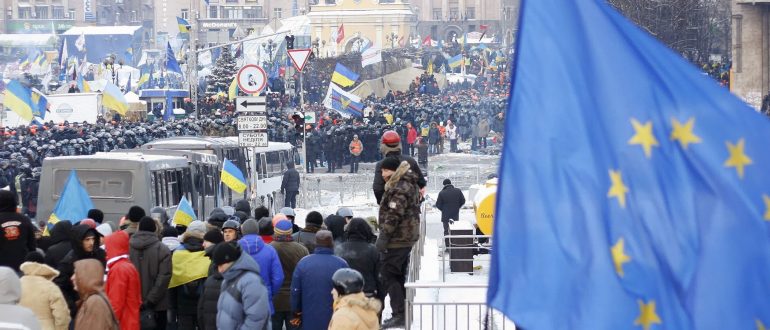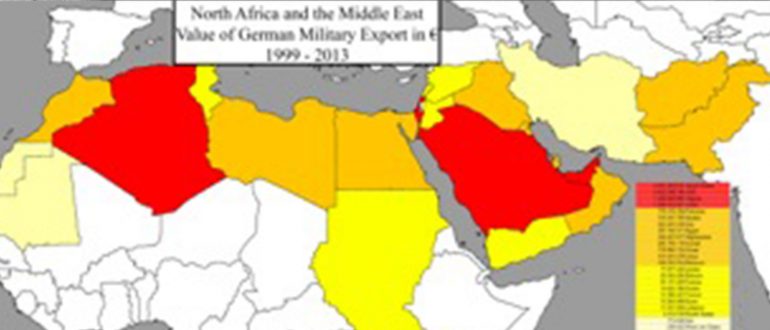The Dokdo/Takeshima Dispute – Power, Institutions, and Identities in East Asia’s ‘other’ territorial conflict
Since 2010, East Asia’s waters are becoming more and more stirred up. With China at the forefront, East Asia’s states are reaching out to satisfy their growing hunger for resources. But the People’s Republic is not the only bully in the schoolyard: For decades, Japan and South Korea have been struggling over two small islands in the Sea of Japan. And while power is a driving factor in all of East Asia’s territorial disputes, there are others at play as well. As this analysis of the Dokdo/Takeshima dispute between Japan and South Korea shows, all major International Relations (IR) schools contribute to understanding the origins of the conflict and the obstacles to its resolution.
1. Background and Recent Developments
The Korean name “Dokdo” and the Japanese “Takeshima” both refer to a small pair of islets in the Sea of Japan (or, as the Koreans call it, East Sea) that are surrounded by several small rocks. Both parties claim the territory, which is since 1954 effectively controlled by South Korea. Seoul bases its claims on what it sees as historical accounts of Korean authority over Dokdo dating back to the 18th century, while Japan disputes this interpretation and points to its incorporation of Takeshima in 1905, some 5 years before the colonization of Korea. The islands, Tokyo argues, have not been included in the territories to be returned to its former colonies after the end of imperial Japan under the provisions of the San Francisco Peace Treaty of 1951.
The most recent escalation of the conflict took place in August this year, when South Korean president Lee Myung-bak paid a surprise visit to Dokdo and nationalists organized a swim to the island to commemorate the anniversary of Korea’s liberation from Japan. Tokyo responded by recalling its ambassador from Seoul. In September, South Korea underlined its determination to defend Dokdo by conducting military drills that simulated the repulsion of enemy forces from its surrounding waters.
Location of the Dokdo/Takeshima island (English-Franco name “Liancourt Rocks) in the Sea of Japan/East Sea).
2. IR schools and the conflict
Why make such a big deal about a tiny patch of land? It is the interplay of several factors that is hampering moves towards a political solution of this seemingly small-scale conflict. IR theory’s main strands can help us identify these factors.
a) Realism
Realism and Neo-Realism stress the need of states to rely on self-help to guarantee their own security in an anarchic international system. Conflicts in the international system result from antagonistic security interests and shifts in the balance of power[1]. With a view to the South Korea-Japan tensions, it’s important to keep in mind that East Asia is currently undergoing profound changes in its regional power configuration. Both South Korea and Japan have benefited a great deal from the stability induced by American hegemony during the Cold War, but as China is rising, a lot of questions remain to be answered: What role is China going to play in the new regional order? In the worst-case-scenario of a war with China, will the U.S. stand by its security guarantees towards Japan and South Korea respectively? Exactly how much burden sharing is Washington going to expect from its Pacific partners? Is there going to be an arms race among the Northeast Asian countries?
The uncertainty about the regional power constellation makes it imperative for both countries to spread their risks and avoid overdependency on external actors. South Korea and Japan, both poor in domestic energy resources, are competing over power sources to decrease dependence on imports from Russia and elsewhere. Both governments are keen on securing access to the potential large methane hydrate reserves in the area surrounding the islands. The same applies for the rich fishing grounds and the strategic importance of the marine territory.
b) Liberalism/Institutionalism
The Liberal school in IR is made up of two strands. Neo-liberal Institutionalism holds that institutions such as international organizations or regimes can help states gain from cooperation by lowering insecurity over other states’ behavior. It is apparent that there is a lack of strong regional or global institutions that could help overcome the differences between South Korea and Japan. The Japanese government has repeatedly proposed to take the matter to the International Court of Justice (ICJ), most recently after the August 2012 saber rattling, but Seoul has refused to do so, insisting in official statements that South Korean sovereignty over Dokdo isn’t contested at all. The ICJ cannot forcibly subject a state to its jurisdiction without its consent, so it cannot contribute to problem-solving. On the regional level, APEC, ASEAN Plus Three and the East Asia Summit (EAS) – the main institutions supporting East Asia’s institutional architecture – have so far basically ignored the issue. The EAS states have held an ASEAN Expanded Maritime Forum in October 2012, but this is basically a dialogue among senior officials and non-government delegates (a so-called “track 1.5 dialogue”), not a high-level institution. Consequenty, it doesn’t have a mandate in conflict-resolution.
The other strand of Liberalism (maybe best called preference-oriented liberalism, following Andrew Moravcsik’s (1997) seminal article) looks into the political systems of the states, stressing the influence of domestic political structures and dynamics on state behavior. Being based on democratically elected governments, the foreign policies of Japan and South Korea are subject to the dynamics of public formation of opinion. Elections are imminent in both countries, and their outcome will have an influence on their future relations with each other. If Japanese opposition leader Shinzo Abe should return as prime minister, the relationship could suffer from his nationalist symbolic politics the same way they did during his first term (2006-07). Only recently, Abe visited the controversial Yasukuni shrine that is believed to house, among others, the souls of Japanese war criminals. In South Korea, conservative president Lee Myung-bak is under pressure from left-wing nationalists who see him as a successor of the elite that collaborated with the Japanese colonial rulers. To appease the left, Lee needs to take a tough stance against Japan. It is hard to determine to what extend the governments are drivers of or hostages to these forces, but it is clear that a nationalist, antagonistic foreign policy on either side would further obstruct a solution to the conflict.
c) Social Constructivism
Constructivist theories stress that in international relations, identities and interests are not exogenously given but constituted in a social process influenced heavily by norms, values and historical experience. Almost 70 years after the end of Japanese 35-year long colonial rule over Korea, the legacy of the past still bears heavy on the two countries’ relations. Although there have been efforts to overcome differences, such as the Joint History Research Committee established in 2001, diverging interpretations of the colonial era prevail, stirring controversy over issues such as forced labor and the so-called “comfort women”. Reconciliation is complicated by Japan’s failure to come to terms with its own past. As a consequence, threat perceptions among South Koreans of the former colonial power are still substantial.
The diverging interpretations of the past result in differing framings of the conflict. As Roh Moo-hyun, then president of South Korea, put it in a speech in 2006, for Koreans Dokdo is “a symbol for the complete recovery of sovereignty [and] a touchstone of the extent to which Japan recognizes its past history” (Moh-hyun 2006). The Japanese challenge to the status of Dokdo/Takeshima is therefore seen as a threat to national integrity and independence, and the defense of the islands is a question of historical justice. Meanwhile, in Japan the issue is more viewed in legalistic terms, stressing the entitlement to what’s rightfully the state’s own property (hence, Tokyo’s proposal to refer to the ICJ). The lack in mutual trust and the different interpretations of the conflict make it hard to find common ground in negotiations.
3. Conclusion
As the previous section shows, the factors fueling the dispute are substantial and profound, which makes it hard to believe that a solution is at hand in the foreseeable future. But the conflict is not just about exogenous power dynamics, which leaves the governments with two options to deal with the row. The first option is to create mutual trust by working in several areas: building robust regional institutions, cooperating in coming to terms with their common past, and resisting the temptations of nationalistic policies. These are long-term tasks that require patience and determination. The other option would be to continue the current approach and accept that the conflict will flare up again from time to time. It’s an option that could work, and I’m not proposing we have to brace ourselves for a South Korean-Japanese war. There are several factors that work against a military escalation, such as the countries’ strong economic interdependence, the U.S.’ pressure for détente, and a strong pacifist majority in Japan. One of the core concepts of the liberal school, the democratic peace theory, suggests the countries are unlikely to go to war with each other because they are both liberal democracies. But to rely exclusively on these counterforces is a long shot given the strong regional dynamics that are so hard to predict. Simply carrying on is the riskier option, but, unfortunately, it’s also the easier one.
by Kilian Spandler
Kilian Spandler has studied political science, sociology, and economics at Würzburg University, at the Université de Genève and the Graduate Institute in Geneva. He is regular author at CISS especially on South and East Asian issues.
Image Source:
Wikipedia (2006): File:Location-of-Liancourt-rocks-en.png (http://en.wikipedia.org/wiki/File:Location-of-Liancourt-rocks-en.png, accessed 24.11.2012).
Sources:
Beck, Peter M. (2011): A Korea-Japan Alliance? (http://www.eastasiaforum.org/2011/06/09/a-korea-japan-alliance/, accessed 09.11.2012).
Buruma, Ian (2012): Ostasien: Inseln des Nationalismus, in: Blätter für deutsche und international Politik 10/2012, pp. 47-48.
Gries, Peter Hays et al. (2009): Historical Beliefs and the Perception of Threat in Northeast Asia: Colonialism, the Tributary System, and China-Japan-Korea Relations in the Twenty-first Century, in: International Relations of the Asia-Pacific 9:2, pp. 245-246.
Moravcsik, Andrew (1997): Taking Preferences Seriously: A Liberal Theory of International Politics, in: International Organisation 51:4, pp. 513-553.
Quinn, Andrew (2012): Clinton Urges Cool Heads in Japan-South Korea Island Dispute (http://www.msnbc.msn.com/id/48959089/ns/world_news-asia_pacific/t/clinton-urges-cool-heads-japan-south-korea-island-dispute/#.UI_lSYbQtoA, accessed 9.11.2012).
Roo Moh-hyun (2006): Special Message on Korea-Japan Relations, April 25th (http://www.google.com/url?sa=t&rct=j&q=&esrc=s&source=web&cd=4&ved=0CD8QFjAD&url=http%3A%2F%2Fnzl-wellington.mofat.go.kr%2Fwebmodule%2Fcommon%2Fdownload.jsp%3Fboardid%3D1467%26tablename%3DTYPE_LEGATION%26seqno%3D073fed04400b042035fb3f95%26fileseq%3Df91fb5041fd9fc6fc6010fc5&ei=BRidUOvkC4bAswbatIHwAg&usg=AFQjCNFxZ9CRx-kj7cG4dDQQDFLfLOEtxA&cad=rja, accessed 9.11.2012).
Hitoshi Tanaka (2012): Japan-ROK Relations: Defusing Tensions to Build a Regional Partnership (East Asia Insights 7:4, October 2012, available at http://www.jcie.org/researchpdfs/EAI/7-4.pdf, accessed 9.11.2012).
[1] I’m aware of the fact that my account of the theory strands given in this contribution are highly simplified and condensed in a way that doesn’t do justice either to the complexity of the approaches or the plurality of academic discussion within those approaches. I refer to the ‘schools’ simply as a way of structuring a comprehensive analysis that takes into account a variety of factors.



